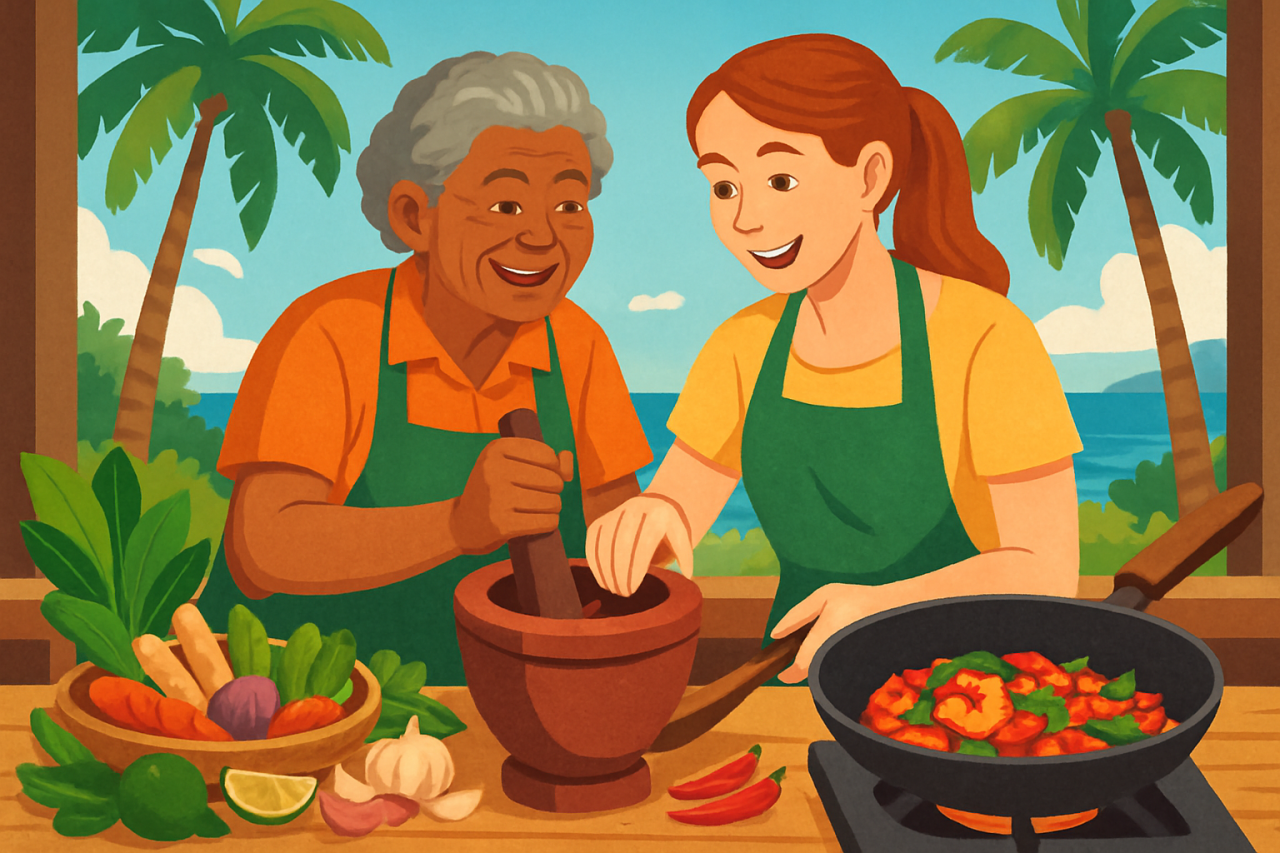There are quicker ways to learn about a place than taking a cooking class with someone’s grandma, but none, I suspect, that are more satisfying—or more delicious. Koh Samui, that palm-fringed jewel in the Gulf of Thailand, is often described as paradise: all turquoise waves and Instagrammable sunsets at Chaweng Beach. But I came seeking something more nourishing than just another white sand day. I wanted to taste the island with all five senses. As it turns out, that journey began in a grandmother’s kitchen.
Koh Samui: Island of Contrasts
Koh Samui’s reputation precedes it. For decades, backpackers and honeymooners alike have flocked to its shores, drawn by stretches like Lamai Beach (you can search for it on Google Maps by typing: Lamai Beach), the golden spires of Wat Plai Laem, or the late-night sizzle and steam of Fisherman’s Village Walking Street. Yet beyond the resorts and reggae bars, there’s a quieter island rhythm, set by the tides and the morning market’s clatter. It’s a place where generations share recipes as easily as they share gossip over iced coffee.
The Cooking Class: More Than Just Pad Thai
I signed up for a half-day cooking class with “Grandma Lek,” a local legend whose culinary wisdom is matched only by her ability to wield a mortar and pestle like a percussion instrument. Her home sits just inland from Bophut Beach—you can search for it on Google Maps by typing: Bophut Beach—a modest, open-air kitchen shaded by coconut palms. If you’ve ever wondered what “farm-to-table” means in Thailand, here it’s literal: the lemongrass comes from the back garden, the coconuts from the neighbor’s tree, the chilies sun-dried on the porch.
Our class began, as all good things do, at the market. The nearby Samui Fresh Market (search: Samui Fresh Market) is a kaleidoscope of color and scent: pyramids of mango, the metallic tang of fresh fish, the bracing snap of kaffir lime leaves. Grandma Lek navigated it like a general, pausing to chat with vendors and appraise the day’s catch. She taught me that the secret to a good green curry isn’t just the recipe, but the ability to haggle with humor and charm.
Mortar, Pestle, and the Alchemy of Taste
Back in the kitchen, the lesson quickly became hands-on. There’s a kind of meditative pleasure to pounding curry paste—garlic, galangal, bird’s eye chilies—into an aromatic paste. Grandma Lek insisted I do it by hand, eschewing the food processor on principle. “Machine makes it too easy,” she said, her eyes twinkling. “You want the taste? You work for it.”
She wasn’t wrong. The fragrance that rose from the mortar was both familiar and startling: a symphony of heat and citrus, as if summer had been distilled into a single spoonful. As we simmered coconut milk (freshly squeezed, of course), she explained how Samui’s cuisine is shaped by the island’s geography. With the sea on one side and coconut plantations on the other, almost every dish is a balancing act between sweetness, spice, and the gentle, nutty richness of coconut.
More Than a Meal: Learning the Island’s Stories
Between courses—green curry, tom yum, som tam papaya salad—Grandma Lek shared stories. She spoke of monsoon seasons that shaped the harvest, of her mother’s kitchen and the way recipes are passed down like family heirlooms. There was humor, too: a running joke about farangs (foreigners) and their notorious fear of chili. (I tried to hide my streaming eyes behind a polite smile. I failed.)
Cooking with Grandma Lek was less like a formal class and more like being welcomed into the fold. She paused often to offer a taste, a correction, or a quiet laugh at my clumsy attempts with the cleaver. This, I realized, was the heart of Samui: hospitality not as performance, but as everyday practice.
Tips for Future Culinary Explorers
If you find yourself in Koh Samui, I can’t recommend a local cooking class highly enough. Here are a few pointers, should you wish to brave the mortar and pestle yourself:
- Book early: Popular classes (especially those run by locals like Grandma Lek) fill up fast, especially during peak season.
- Wear comfortable clothing: Thai kitchens are hot—both literally and figuratively.
- Don’t be shy: Ask questions, taste everything, and embrace your mistakes. The best stories are born from culinary disasters.
- Visit the local markets: Whether it’s Samui Fresh Market or the boisterous stalls at Maenam Walking Street (search: Maenam Walking Street), the market is the true heart of Thai cooking.
Beyond the Plate
Koh Samui will always be, for some, a place of sunsets and soft waves. But for me, it’s now also the memory of a kitchen filled with laughter and the sharp, sweet perfume of basil crushed by hand. Food, in the end, is never just about sustenance. It’s about lineage, landscape, and the ties that bind us across generations and continents. And if you’re lucky, it’s about learning that sometimes, the best way to understand a place is with a spoon in one hand and a story in the other.
If you go, bring an appetite—for food, for learning, and for the quiet, everyday wisdom of grandmothers everywhere. Koh Samui may dazzle with its beaches, but it’s the kitchens that will truly steal your heart.

Comments (0)
There are no comments here yet, you can be the first!